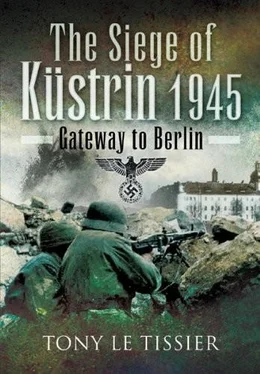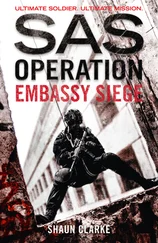The 2nd Guards Tank Army: Berlinchen, Landsberg, Friedeberg; the 1st Guards Tank Army: Meseritz, Schwiebus, Tirschtiegel.
Upon reaching this line, the formations, particularly the artillery and the logistical establishments, shall halt, supplies be replenished and the combat vehicles put in order. Upon full deployment of the 3rd Shock and 1st Polish Armies, the Front’s entire forces shall continue the advance on the morning of the 2nd February, 1945, with the immediate mission of crossing the Oder in their drive, and shall subsequently strike out at a rapid pace towards Berlin, directing their main effort at enveloping Berlin from the north-east, the north and northwest. [5]
In Zhukov’s orders issued on 27 January he stated:
There is evidence that the enemy is hastily bringing up his forces to take up defensive positions on the approaches to the Oder. If we manage to establish ourselves on the western bank of the Oder, the capture of Berlin will be guaranteed.
To carry out this task each army will detail one reinforced rifle corps… and they shall be immediately moved forwards to reinforce the tank armies fighting to secure and retain the position on the west bank of the Oder. [6]
Zhukov continued his forward planning and the next day further details emerged. Once across the Oder, the 5th Shock Army was to thrust towards Bernau, north-east of Berlin, the 8th Guards Army towards Buckow, Alt Landsberg and Weissensee, and the 69th Army towards Frankfurt-an-der-Oder, Boossen and Herzfelde, all three armies operating between the water boundaries formed by the Finow Canal in the north and the Spree River in the south.
No mention of Küstrin was made in these orders, yet it had the only road and rail bridges across the Oder for a considerable distance in either direction. The only available alternatives to the Küstrin bridges were the road bridges at Frankfurt, 27 kilometres to the south, and at Hohenwutzen, 46 kilometres to the north, and the railway bridges at Frankfurt, 30 kilometres to the south, and at Zäckerick, 38 kilometres to the north. Presumably Zhukov expected these bridges to be blown in the face of his advance, thus obliging his men to use their own resources to cross the river.
In accordance with Zhukov’s instructions of the 27th, the 1st Byelorussian Front’s armies widened the arc of their advance towards the Oder, sending strong vanguards ahead of each army, corps and division. The prospect of rising temperatures forced them to quicken their pace even further in the hope that the ice would still be holding when they reached the Oder, thus simplifying their crossing. A medal that had been struck the year before for commanders who gained bridgeheads no doubt acted as an added incentive. However, in this approach across a wide arc, the Front was uncomfortably split by the Warthe estuary (Warthebruch), while the southern element also had the handicap of the gap in the lines of communication caused by the stubbornly held Posen fortress.
The 1st Guards Tank Army and those elements of the 8th Guards and 69th Armies not involved in the siege of Posen fanned out south of the Warthebruch, with the 33rd Army even further south on the Front’s left flank. Colonel Babadshanian described what happened when his troops reached the Tirschtiegel Riegel with its Maginot-like defences that had long been stripped of their guns for the Atlantic Wall:
On the evening of the 26th January, the vanguard of the 11th Guards Tank Corps, Colonel Morgonov’s 45th Guards Tank Brigade, reached the town of Tirschtiegel and the former German–Polish border. Before us lay the Obra River, beyond began Germany.
How long we had yearned for this day, and now it was there. We just had to take one more step and we would be standing on German soil. Our spirits rose. The vanguard tried to take the river on the move, but it was not so easy, as the enemy had blown all the bridges in his retreat and offered bitter resistance.
The 45th Guards Tank Brigade attacked Tirschtiegel in vain on the 26th January. On the night leading to the 27th January, Colonel Gussakovski’s 44th Guards Tank Brigade circumvented the town to the north, forced the Odra and thrust on to Hochwalde without encountering any resistance.
At 0300 hours the brigade’s vanguard, Major Karabnov’s 3rd Battalion, came up against a barricade across the road. The engineers made a reconnaissance. To the left and right of the road were ranged anti-tank ditches covered by minefields and concrete obstacles. The engineers pulled out the girders supporting the barricade, and the tanks were able to continue.
Gussakovski had reached the so-called Oder Triangle, the fortified area of Meseritz, a strong and difficult-to-take obstacle on the way to the Oder that began on the west bank of the Obra. This main line of defence strip extended between Schwerin, Meseritz and Schwiebus about 20 kilometres further west.
The Oder Triangle formed a massive defensive installation. It consisted of numerous reinforced concrete bunkers, so-called armoured works, incorporating the latest technical measures and echelonned to a depth of up to 6 kilometres. These armoured works went down two or three storeys into the earth and were mounted with armoured cupolas with artillery pieces and machine guns that could be exposed or retracted. The walls were up to 2.5 metres thick and the cupolas had 350 millimetres of armour. These armoured works were connected by underground passages, had their own power and air filter systems, water and drainage systems, ammunition and food stores. They were further reinforced with field works, anti-tank ditches, barricades, barbed wire and minefields. In front of the main defensive installation was a chain of lakes running from north to south.
As quickly as possible, our corps regrouped north of Schwiebus and entered the fortified area from the rear without encountering strong resistance. Once the enemy realised that he was surrounded, many of the garrisons surrendered to our all-arms armies following up behind. [7]
North of the Warthebruch, both the 5th Shock Army and the 2nd Guards Tank Army, less one corps already detached to cover the Front’s exposed northern flank, passed through Landsberg on the 30th, heading for the Oder. The ice on the river was still thick enough to take trucks, but a tank fell through the ice when it tried to follow them across. The troops crossed over to the west bank taking antitank guns with them, and occupied the village of Kienitz at 0400 hours on 31 January. They found six German officers with 63 young Reichsarbeitsdienst gunners asleep in a train at the village station and captured their six flak guns. A couple of the villagers managed to get away to warn the authorities in Wriezen. [8]
The southern Soviet vanguard continued on its way, pushing forwards along the axis Tauerzig–Polenzig–Göritz. The main body was unable to take advantage of its vanguard’s success and had to fight its way through the old German border defences, which took the whole of the two days of 30 and 31 January to achieve, but resulted in the complete destruction of the 21st SS Mountain Division ‘Skanderberg’. It arrived opposite the village of Reitwein on 2 February and immediately started crossing the Oder, even though the ice was already beginning to break up. [9]
Meanwhile General Theodor Busse had been given command of the German 9th Army as part of Army Group ‘Weichsel’ (Vistula), which was taken over on 22 January by Reichsführer-SS Heinrich Himmler, whose practical military experience was limited to basic training as a teenage volunteer towards the end of the First World War. Following the attempt on Hitler’s life on 20 July 1944, the Nazi leadership had become highly mistrustful of military commanders and Himmler’s appointment was a direct consequence. Himmler immediately set off in his luxurious personal train to Deutsch-Krone in Pomerania but he had neither a direct communications link to the Wehrmacht command network nor any maps, apart from one which the newly appointed operations officer happened to bring along with him four days later. No sooner had Himmler issued his first orders than the Soviet advance forced him to withdraw westwards again. The ineptness of this appointment system was underlined on the 27th with the appearance of Himmler’s Chief of Staff, SS-Brigadier Lammerding, who proved to have no staff experience. [10]
Читать дальше












